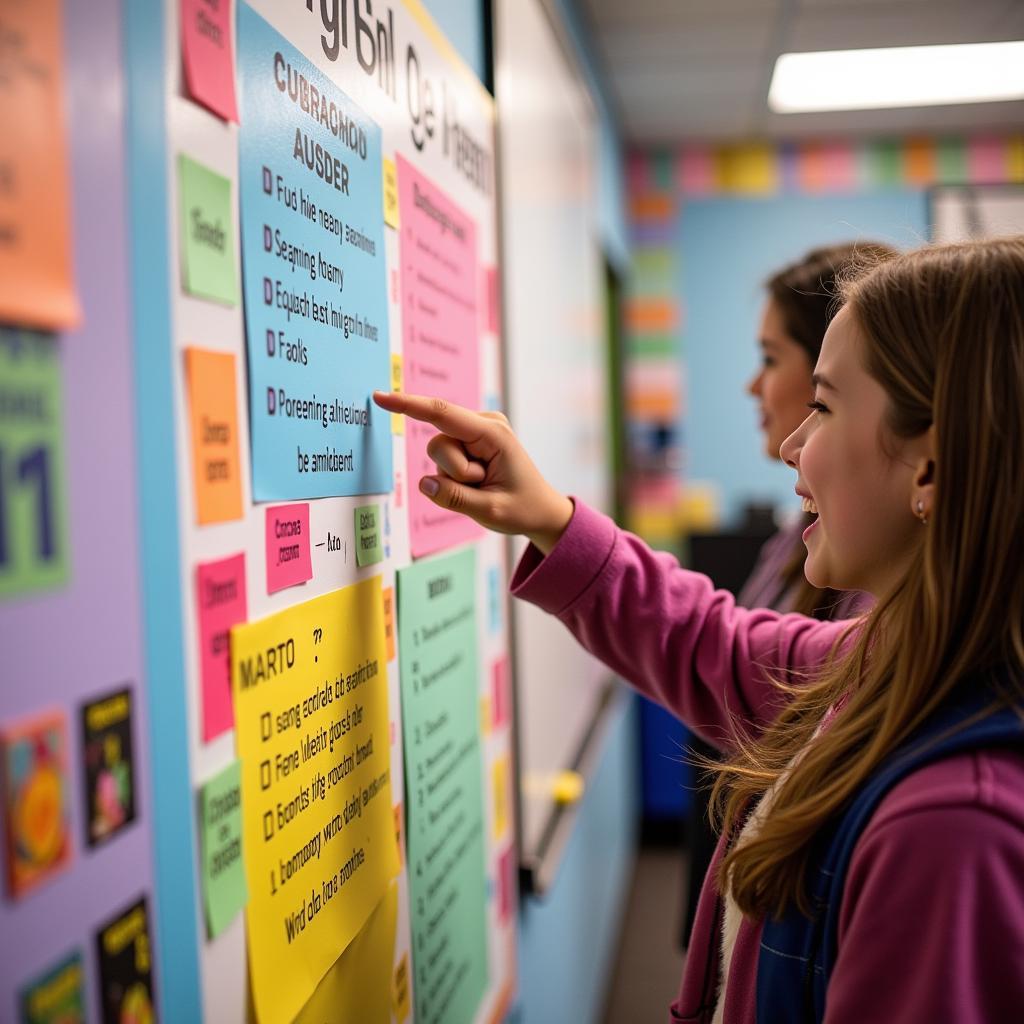Engaging Learners with Choice Boards for Language Arts
Choice boards are transforming the landscape of language arts education, empowering students to become active participants in their learning journey. By offering a menu of engaging activities, choice boards cater to diverse learning styles and preferences, fostering motivation and ownership over the learning process.
 A student enthusiastically selects an activity from a vibrant and interactive language arts choice board, showcasing a variety of options such as writing prompts, reading challenges, and creative projects.
A student enthusiastically selects an activity from a vibrant and interactive language arts choice board, showcasing a variety of options such as writing prompts, reading challenges, and creative projects.
What are Choice Boards for Language Arts?
Imagine a tic-tac-toe board, but instead of X’s and O’s, it’s filled with stimulating language arts activities! That’s the essence of a choice board. It’s a visual organizer that presents students with a variety of tasks related to a specific theme, topic, or skill. Students then have the freedom to choose which activities they want to complete, often with a requirement to fulfill a certain number or combination of tasks.
This element of choice is key. It taps into students’ intrinsic motivation, allowing them to gravitate towards activities that resonate with their interests and learning styles. Whether they’re drawn to writing poetry, delivering presentations, or crafting visual representations of their understanding, choice boards offer a pathway for every student to shine.
Why Use Choice Boards in Language Arts?
The beauty of choice boards lies in their versatility and adaptability. They can be easily tailored to different grade levels, learning objectives, and even time constraints. Here’s why educators are increasingly integrating choice boards into their language arts instruction:
-
Differentiated Instruction: Choice boards cater to diverse learners by providing options that vary in complexity, format, and learning modality. This allows students to work at their own pace and challenge level.
-
Student Agency: Empowering students to make choices fosters a sense of ownership and responsibility over their learning.
-
Engagement and Motivation: The element of choice combats monotony and keeps students engaged. They’re more likely to be invested in activities they’ve chosen themselves.
-
Skill Development: Choice boards can be designed to target specific language arts skills, whether it’s creative writing, reading comprehension, vocabulary building, or persuasive speaking.
 A teacher enthusiastically explains the diverse range of options on a language arts choice board to a group of engaged students.
A teacher enthusiastically explains the diverse range of options on a language arts choice board to a group of engaged students.
How to Create Effective Choice Boards for Language Arts
Designing a captivating and effective choice board requires thoughtful planning and an understanding of your students’ needs and interests. Here’s a step-by-step guide:
-
Define Your Learning Objectives: Start by pinpointing the specific language arts skills or knowledge you want students to gain through the choice board activities.
-
Choose a Theme or Topic: A central theme can tie the activities together and make the learning experience more cohesive and engaging.
-
Select a Variety of Activities: Offer a range of tasks that cater to different learning styles and modalities. Include options for visual learners, auditory learners, kinesthetic learners, and those who thrive on collaboration.
-
Provide Clear Instructions: Each activity should have concise and easy-to-understand instructions, ensuring that students can work independently.
-
Set Expectations and Deadlines: Clearly communicate the number of activities students are expected to complete and the timeframe for completion.
Examples of Engaging Choice Board Activities:
Looking for inspiration? Here are some examples of captivating activities you can include on your language arts choice boards:
- Write a poem, song, or rap about the main character.
- Create a comic strip that retells a scene from the story.
- Design a travel brochure for the setting of the book.
- Deliver a persuasive speech arguing for or against a character’s actions.
- Conduct and film an interview with a character from the book.
- Research and present a report on a historical event or figure related to the story.
Tips for Implementation
-
Introduce the Choice Board Clearly: Thoroughly explain the purpose, structure, and expectations of the choice board to students before they begin.
-
Provide Time for Exploration: Allow students some time to browse the choice board and consider their options before making their selections.
-
Offer Support and Guidance: Be available to answer questions, clarify instructions, and provide support as students work on their chosen activities.
-
Encourage Reflection: Incorporate opportunities for students to reflect on their learning, the choices they made, and the challenges they encountered.
Conclusion
Choice boards are a powerful tool for transforming language arts classrooms into dynamic and engaging learning environments. By providing students with choice, educators can tap into their intrinsic motivation, cater to their diverse learning needs, and foster a love for language and literacy.

